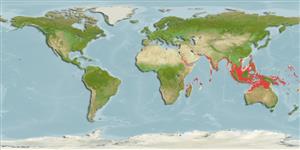Elasmobranchii (hajar och rockor) (sharks and rays) >
Torpediniformes (Electric rays) >
Narcinidae (Numbfishes)
Etymology: Narcine: Greek, narke = numbness (Ref. 45335).
Environment: milieu / climate zone / depth range / distribution range
Ekologi
marina bottenlevande. Tropical
Indo-West Pacific: off Pakistan to the Gulf of Thailand.
Length at first maturity / Size / Vikt / Age
Maturity: Lm ?, range 14 - ? cm
Max length : 22.0 cm TL hane/ej könsbestämd; (Ref. 9912)
Found in continental waters, both inshore and offshore (Ref. 9912). Biology little known (Ref. 9912).
Life cycle and mating behavior
Könsmognad | Reproduktion | Lek | Ägg | Fecundity | Larver
de Carvalho, M.R., L.J.V. Compagno and P.R. Last, 1999. Narcinidae. Numbfishes. p. 1433-1442. In K.E. Carpenter and V.H. Niem (eds.) FAO species identification guide for fishery purposes. The living marine resources of the Western Central Pacific. Vol. 3. Batoid fishes, chimaeras and bony fishes. Part 1 (Elopidae to Linophrynidae). FAO, Rome. (Ref. 9912)
IUCN Red List Status (Ref. 130435: Version 2024-2)
Human uses
Verktyg
Special reports
Download XML
Internet-källor
Estimates based on models
Preferred temperature (Ref.
123201): 23.7 - 28.6, mean 27.4 °C (based on 1072 cells).
Phylogenetic diversity index (Ref.
82804): PD
50 = 0.5000 [Uniqueness, from 0.5 = low to 2.0 = high].
Bayesian length-weight: a=0.01175 (0.00470 - 0.02937), b=2.88 (2.66 - 3.10), in cm total length, based on LWR estimates for this (Sub)family-body shape (Ref.
93245).
Trofisk nivå (Ref.
69278): 3.1 ±0.3 se; based on size and trophs of closest relatives
Resiliens (Ref.
120179): Låg, lägsta populationsfördubblingstid 4,5-14 år (Assuming fecundity<100).
Fishing Vulnerability (Ref.
59153): Low vulnerability (12 of 100).
